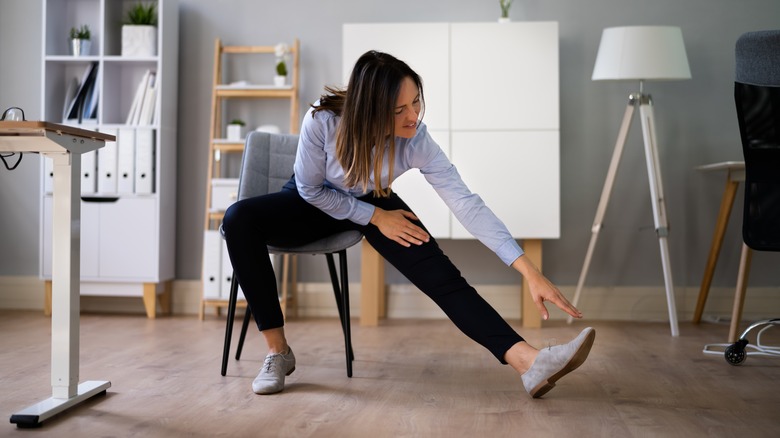The Best Way To Sit To Minimize SI Joint Pain
Pain in your sacroiliac joint can be a pain in the ... well, you know. Because the SI joint supports the weight of your upper body, sitting puts pressure on this joint, according to Genesis Pain Clinic. The SI joint connects the sacrum, which is the flat bone at the base of your spine, to the ilium bone, which is the wing-like part of your pelvis. Unlike the joints of your elbow or knee, the SI joint allows for little movement. However, if this joint becomes injured or inflamed, you'll feel this pressure in the lower back.
To minimize pain in your SI joint while sitting, Genesis Pain suggests finding an orthopedic pillow or towel to place under your seat and spreading your knees slightly outward. It's also important to take frequent breaks from sitting at an office desk and take short walks throughout the day. This allows for regular blood flow in the area of the SI joint.
You can also make some adjustments to your environment to help minimize pain. Hinge Health suggests adjusting the height of your chair so that your hips are higher than your knees. Be sure your feet aren't dangling, though, so use a footstool if necessary. You can also swap your chair for an exercise ball. If you like to sit on the floor, sit on a pillow so your hips are higher. You can also sit on your calves and place the pillow between your seat and calves.
What causes SI joint pain?
According to Premier Health, SI joint pain, or sacroiliitis, is tough to distinguish between other types of lower back pain. Your pain can sometimes radiate down to your butt or your legs, so it can easily be mistaken for a herniated disc or lumbar spinal stenosis. Women in their 30s account for 80% of people with SI joint pain, mostly because of hormonal changes to prepare for childbirth.
Other causes for SI joint pain could be the length of your legs or scoliosis, according to Spine-Health. This can cause one side of the pelvis to feel more pressure than the other, which places undue stress on that joint. If you play a sport or have a job that stresses the lower back, you could experience SI joint pain. People who've had previous back surgeries might think they're free from lower back pain, but fusion surgery and hip replacements can also lead to pressure on the SI joint. And obviously, a bad fall can also cause inflammation of your SI joint.
Seated exercises for SI joint pain
While you're seated, you can exercise the areas that support your SI joint while also loosening areas around the pelvis. The first exercise is a hip abduction, where you plant one foot while moving the opposite bent leg out to the side. Your working leg doesn't have to rise high off the floor, just enough to be able to create space between your legs. You can also place a rolled towel between your knees for a hip adduction exercise by squeezing into the towel. Both exercises help strengthen the muscles of the hip while also resetting the SI joint, according to Hinge Health.
Another exercise is a seated hamstring stretch to help balance the pelvis. Extend one leg straight while keeping the other foot planted on the floor, then bend until you feel a light stretch along the back of your legs. You can also try a seated glute stretch to stretch the piriformis muscle that runs along your glutes. It will also improve the flexibility and mobility of your back. Cross one ankle over the opposite knee then hinge at your hips to reach your chest forward until you feel a stretch in your hip and glute. Although glute bridges aren't done sitting in a chair, they can help support your SI joint as well.



